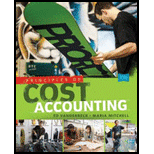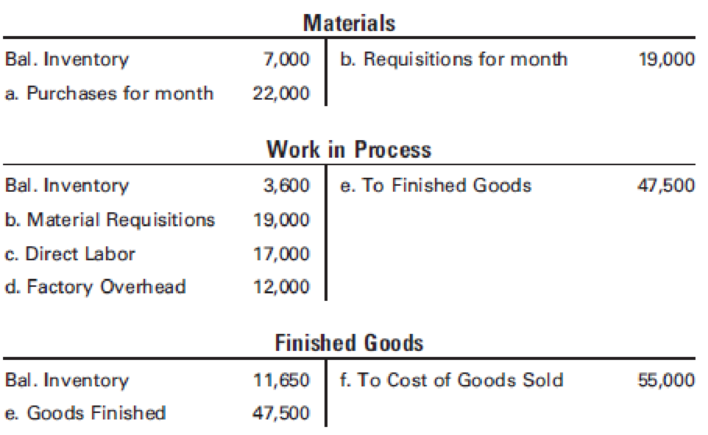
Principles of Cost Accounting
17th Edition
ISBN: 9781305087408
Author: Edward J. Vanderbeck, Maria R. Mitchell
Publisher: Cengage Learning
expand_more
expand_more
format_list_bulleted
Textbook Question
Chapter 2, Problem 9P
Tuscany Products, Inc. uses a

Required:
- 1. Analyze the accounts and describe in narrative form what transactions took place. (Use the reference letters a. through f. in your explanations and note that some accounts needed in your explanation have been purposely omitted.)
- 2. List the supporting documents or forms required to record each transaction involving the receipt or issuance of materials.
- 3. Determine the ending balances for Materials, Work in Process, and Finished Goods.
Expert Solution & Answer
Want to see the full answer?
Check out a sample textbook solution
Students have asked these similar questions
Jensen Manufacturing’s Work-in-Process Inventory on January 1 had a balance of $34,200. During the year, $70,800 of direct materials were issued to production. Total manufacturing wages incurred were $93,000, of which $72,000 were direct labor. Manufacturing overhead is applied at 120% of direct labor cost. Actual overhead was $95,600. Jobs totaling $248,000 were completed during the year. What is the December 31 balance of Work-in-Process Inventory?
Xander Industries has a balanced day of 31 December. On 1 January 2XX5, it had an opening inventory balance of $32,500. Xander Industries purchased $48,700 worth of goods for resale. On 31 December 2XX5, the closing inventory balance was $19,200. During the year, Xander Industries had sales of $74,000. What is the Cost of Goods Sold for Xander Industries for the period ending 31 December 2XX5? HELP
I am looking for the correct answer to this financial accounting question with appropriate explanations.
Chapter 2 Solutions
Principles of Cost Accounting
Ch. 2 - What are the two major objectives of materials...Ch. 2 - Prob. 2QCh. 2 - What factors should management consider when...Ch. 2 - Prob. 4QCh. 2 - What kind of information and data are needed to...Ch. 2 - How would you define the term economic order...Ch. 2 - What kind of information and data are needed to...Ch. 2 - What factors should be considered when determining...Ch. 2 - Prob. 9QCh. 2 - Prob. 10Q
Ch. 2 - Prob. 11QCh. 2 - Proper authorization is required before orders for...Ch. 2 - Prob. 13QCh. 2 - Prob. 14QCh. 2 - Prob. 15QCh. 2 - Prob. 16QCh. 2 - Prob. 17QCh. 2 - Normally, a manufacturer maintains an accounting...Ch. 2 - Prob. 19QCh. 2 - Why do companies adopt the LIFO method of...Ch. 2 - Prob. 21QCh. 2 - Prob. 22QCh. 2 - Prob. 23QCh. 2 - Prob. 24QCh. 2 - Prob. 25QCh. 2 - Prob. 26QCh. 2 - Prob. 27QCh. 2 - Prob. 28QCh. 2 - A manufacturing process may produce a considerable...Ch. 2 - After a product is inspected, some units may be...Ch. 2 - Order Point Pershing, Inc. expects daily usage of...Ch. 2 - Economic order quantity; order cost; carrying cost...Ch. 2 - Economic order quantity; order cost; carrying cost...Ch. 2 - Journalizing materials requisitions Penrose...Ch. 2 - Recording materials transactions Prepare a journal...Ch. 2 - PurrChems raw materials records contained the...Ch. 2 - Using first-in, first-out perpetual inventory...Ch. 2 - LIFO costing Using last-in, first-out perpetual...Ch. 2 - Using the weighted average method of perpetual...Ch. 2 - Prob. 10ECh. 2 - Renfro, Inc. was franchised on January 1, 2016. At...Ch. 2 - Recording materials transactions Craig Products...Ch. 2 - Recording materials transactions Broadwell...Ch. 2 - JIT and cost control Matsui Industries produces...Ch. 2 - Kenkel, Ltd. uses backflush costing to account for...Ch. 2 - For E2-15, prepare any journal entries that would...Ch. 2 - Davis Co. uses backflush costing to account for...Ch. 2 - For E2-17, prepare any journal entries that would...Ch. 2 - A machine shop manufactures a stainless steel part...Ch. 2 - Spoiled work Roger Company manufactures tennis...Ch. 2 - Defective work Herbert Electronics manufactures an...Ch. 2 - Perry Co. predicts it will use 25,000 units of...Ch. 2 - Prob. 2PCh. 2 - Economic order quantity; tabular computation Lopez...Ch. 2 - In P2-3, assume that the company desires a safety...Ch. 2 - Inventory costing methods The purchases and issues...Ch. 2 - Inventory costing methods The following...Ch. 2 - Terrills Transmissions uses a job order cost...Ch. 2 - Prob. 8PCh. 2 - Tuscany Products, Inc. uses a job order cost...Ch. 2 - Prob. 10PCh. 2 - JIT and cost control Langray, Ltd. produces 50,000...Ch. 2 - Backflush costing Russell Corp. uses backflush...Ch. 2 - Webster Company uses backflush costing to account...Ch. 2 - An examination of Buckhorn Fabricators records...Ch. 2 - One of the tennis rackets that Ace Sporting Goods...Ch. 2 - Lloyd Industries manufactures electrical equipment...Ch. 2 - Review Problem for Chapters 1 and 2 UltraLift...Ch. 2 - Financial and Nonfinancial Aspects of Changing to...Ch. 2 - Prob. 2MC
Knowledge Booster
Learn more about
Need a deep-dive on the concept behind this application? Look no further. Learn more about this topic, accounting and related others by exploring similar questions and additional content below.Similar questions
- I need the correct answer to this financial accounting problem using the standard accounting approach.arrow_forwardI need help finding the accurate solution to this general accounting problem with valid methods.arrow_forwardI need help finding the accurate solution to this general accounting problem with valid methods.arrow_forward
arrow_back_ios
SEE MORE QUESTIONS
arrow_forward_ios
Recommended textbooks for you
 Cornerstones of Cost Management (Cornerstones Ser...AccountingISBN:9781305970663Author:Don R. Hansen, Maryanne M. MowenPublisher:Cengage Learning
Cornerstones of Cost Management (Cornerstones Ser...AccountingISBN:9781305970663Author:Don R. Hansen, Maryanne M. MowenPublisher:Cengage Learning

Cornerstones of Cost Management (Cornerstones Ser...
Accounting
ISBN:9781305970663
Author:Don R. Hansen, Maryanne M. Mowen
Publisher:Cengage Learning
IAS 29 Financial Reporting in Hyperinflationary Economies: Summary 2021; Author: Silvia of CPDbox;https://www.youtube.com/watch?v=55luVuTYLY8;License: Standard Youtube License